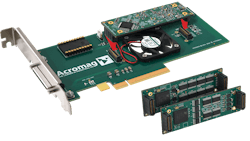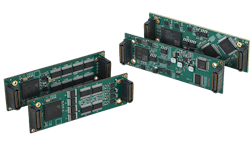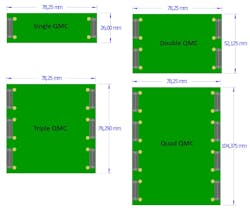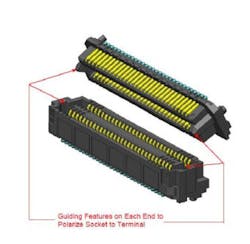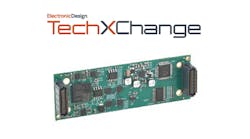VITA 93 QMC Modules and Carrier Boards Now Available
What You'll Learn
- What is VITA 93 QMC?
- What mezzanine cards are now available.
- Why VITA 93 QMC is important.
Acromag recently released a number of new VITA 93 QMC small-form-factor mezzanine cards and matching carrier boards (Fig. 1):
- QMC350: Analog input module with 20 channels performing 1-MSPS 16-bit analog-to-digital conversion
- QMC440: Digital input module featuring 32 optically isolated channels with interrupts
- QMC450: Digital output module providing 32 isolated solid-state relays for AC-DC switching
- QMC510: Octal serial communication module programmable for RS-232/422/485 interfaces
- QMC520: Quad isolated serial communication module with RS-232/422/485 ports
- QMC730: Multifunction I/O module combining analog I/O, digital I/O, and counter/timers
They also released a half-length PCI Express (PCIe) carrier card with a single QMC slot.
The single-width VITA 93 QMC mezzanine modules are slightly larger than a long M.2 module. The QMC modules are designed for high-speed operation and the ability to work in a rugged environment with converntion or conduction cooling. Each module has four mounting holes so that the module can be bolted to the carrier board. This is critical for applications where shock and vibration can be an issue. It also provides better mating for conduction-cooled applications.
The pair of connectors provides a x4 PCI Expess (PCIe) Gen 4 interface plus 20 differential or 40 single-ended I/O ports with lots of ground lines to provide clean signals. The I/O connections are organized as five I/O pipes. The modules also have an I2C interface that supports the intelligent platform management interface (IPMI); An I2C serial memory device on the module can provide configuration information. More advanced systems typically offer configurable settings.
“These VITA 93 QMC modules are engineered to meet increasing demands for smaller form factors and more performance,” explained Robert Greenfield, Acromag’s Business Development Director. “At less than quarter the size of a PMC/XMC module and offering much higher performance than mini PCIe, QMC modules are ideal for smaller computers used in unmanned vehicles and narrow payload tubes.”
VITA 93 QMC Sports Multiple Form Factors
The VITA 93 QMC standard defines four different, compatible form factors (Fig. 2). The new modules from Acromag fit in a Single QMC slot. The standard defines the layout for the mezzanine cards as well as carrier boards. Carrier boards with multiple slots can handle different combinations of mezzanine modules depending on the layout of the carrier board and the modules that are used with it.
The double, triple, and quad layouts are designed to handle a mix of mezzanine modules. For example, they can manage two, three, and four Single QMC modules, respectively, in addition to a Double QMC mezzanine module that fits into a Double QMC slot on a carrier board. Wider modules provide more bandwidth and more I/O connections. The wider modules support larger chips like GPGPUs and AI accelerators that need more space and bandwidth.
Carrier boards can be custom or based on standard form factors like the PCIe card, as well as 3U and 6U boards that support OpenVPX or CompactPCI-Serial in addition to small-form-factor standards like VNX+ and PC/104.
A Closer Look at VITA 93 QMC Connectors
The VITA 93 QMC standard defines a pair of connections on a single QMC module. The connectors are based on the AcceleRate HD Ultra-Dense Slim Body Array connectors from Samtec (Fig. 3). The 80-pin (4 × 20) connectors are available in 9-, 11-, 14-, and 16-mm stack heights. The modules have a limited height on top and bottom, giving taller sockets space for components on the carrier board.
Why VITA 93 QMC is Important
The VITA 93 QMC standard fills a gap in small-form-factor, rugged modular design that's been filled by proprietary solutions or form factors like M.2, which lack the physical structure needed for applications dealing with shock and vibration issues. The open standard is supported by a number of vendors and backed by VITA.
The detailed specifications are key to streamlining the design process, as the amount of power and cooling is addressed in a standard fashion.
More VITA 93 QMC Articles and Videos
About the Author
William G. Wong
Senior Content Director - Electronic Design and Microwaves & RF
I am Editor of Electronic Design focusing on embedded, software, and systems. As Senior Content Director, I also manage Microwaves & RF and I work with a great team of editors to provide engineers, programmers, developers and technical managers with interesting and useful articles and videos on a regular basis. Check out our free newsletters to see the latest content.
You can send press releases for new products for possible coverage on the website. I am also interested in receiving contributed articles for publishing on our website. Use our template and send to me along with a signed release form.
Check out my blog, AltEmbedded on Electronic Design, as well as his latest articles on this site that are listed below.
You can visit my social media via these links:
- AltEmbedded on Electronic Design
- Bill Wong on Facebook
- @AltEmbedded on Twitter
- Bill Wong on LinkedIn
I earned a Bachelor of Electrical Engineering at the Georgia Institute of Technology and a Masters in Computer Science from Rutgers University. I still do a bit of programming using everything from C and C++ to Rust and Ada/SPARK. I do a bit of PHP programming for Drupal websites. I have posted a few Drupal modules.
I still get a hand on software and electronic hardware. Some of this can be found on our Kit Close-Up video series. You can also see me on many of our TechXchange Talk videos. I am interested in a range of projects from robotics to artificial intelligence.
